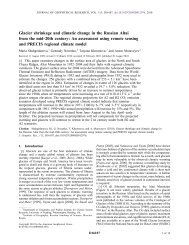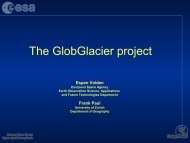Download - GLIMS: Global Land Ice Measurements from Space
Download - GLIMS: Global Land Ice Measurements from Space
Download - GLIMS: Global Land Ice Measurements from Space
- No tags were found...
You also want an ePaper? Increase the reach of your titles
YUMPU automatically turns print PDFs into web optimized ePapers that Google loves.
18CHAPTER 2. THE <strong>GLIMS</strong> - PROJECT AND RELEVANT GLACIER CHARACTERISTICS2.3 The Use of Remote Sensing in Glacier MappingA main advantage in using space borne remote sensing data for glacier monitoringis the coverage of large area. This enables the scientists to monitor all glaciers ofan extended area at the same time. Another advantage is the possibility of frequentrepeat observations. Moreover, some of the new sensors have stereo capability enablingthe retrieval of digital elevation models (DEM). Multispectral data enableautomatic glacier classication using the spectral properties of snow and ice.Problems result <strong>from</strong> cloudiness, because the acquisition time depends on the satelliteorbit. Also shadowed and debris covered parts of the glaciers can cause problemsin classifying.2.3.1 Optical Properties of <strong>Ice</strong> and SnowAs described before the spectral properties of snow and ice are of relevance for multispectralclassication of glaciers. In the visible part of the spectrum the reectance ofsnow depends on pollutants (e.g. soot) but not on the grain size. In the near-infraredthe reection of snow and ice depends on the grain size whereas the dependence onpollution decreases. In addition, the spectral reection of snow depends on thesurface roughness and to a very small part on the liquid water content.In the <strong>Land</strong>sat 5 TM bands TM1 - TM4 (0.45 µm - 0.9 µm) and the ASTER bandsA1 - A3 the reectance of snow is very high. <strong>Ice</strong> is darker in the visible part of thespectrum and also in the near infrared ice has a lower reectance. In the short waveinfrared, TM5 and TM7 and ASTER A4 - A5, the reection of snow is very lowand strongly depends on the grain size which makes ice even lower in the reection.In the near infrared the reection decreases with growing grain size and increasingwave length. The reection of liquid cloud particles is very high also in the shortwave infrared between 1.6 µm and 1.8 µm. This enables separate classication ofclouds in the images because of their high reection. Problems occur in both sensorswith snow in shadow of e.g. clouds or mountain ridges and also with ice clouds.Figure 2.6a shows the reection of snow for various grain sizes for the <strong>Land</strong>sat 5TM bands. Figure 2.6b shows the reection of dierent types of snow and ice of aglacier after in situ measurements.Figure 2.7 shows the model calculation by Wiscombe and Warren (Wiscombe andWarren, 1980) for the spectral reectivity of snow in relation to the grain size. Itclearly indicates the dependence of the reectance on the grain size. In the visiblepart of the spectrum the albedo is not very sensitive to grain size, whereas in the





